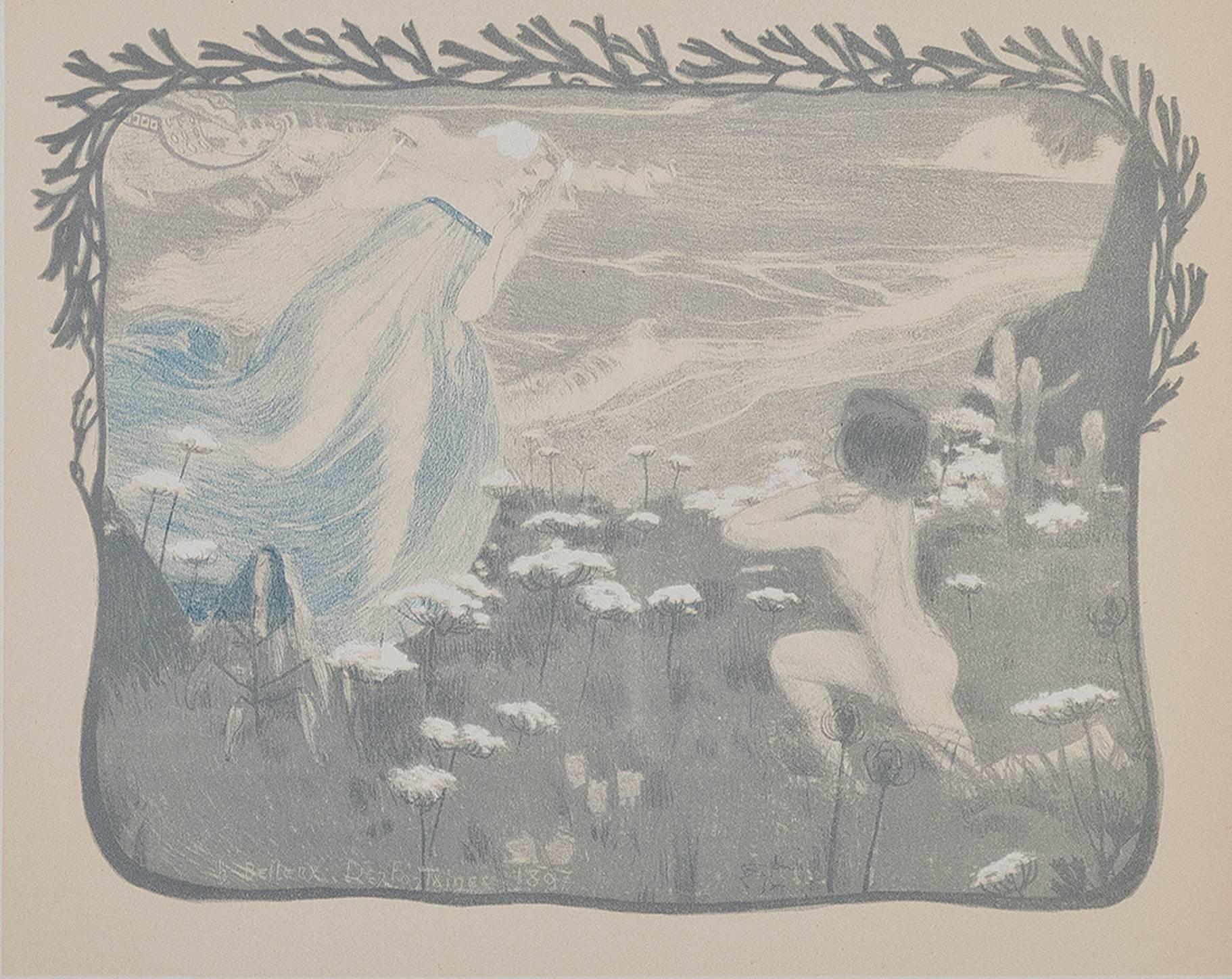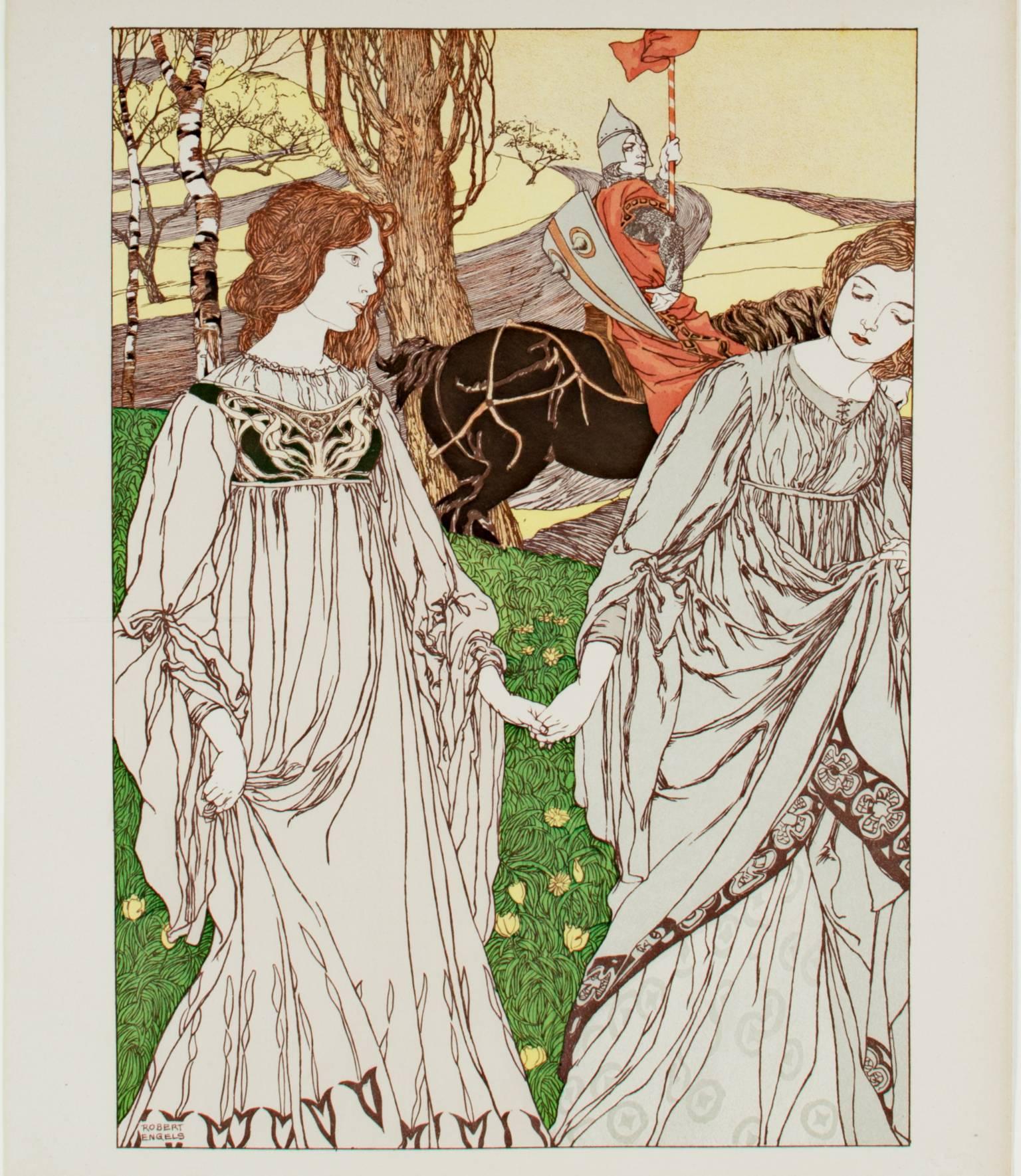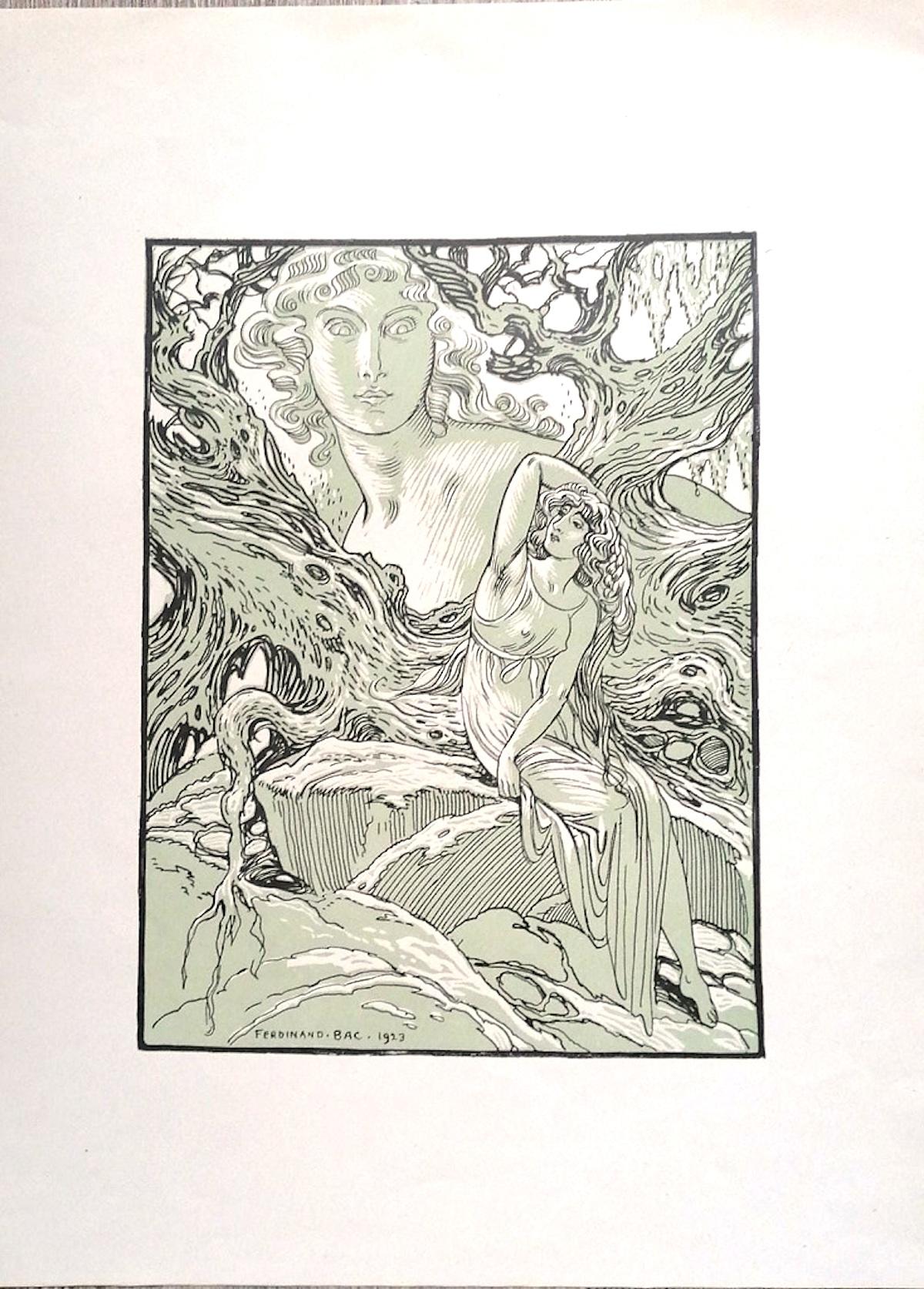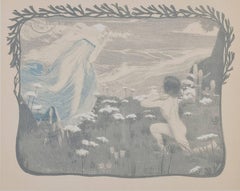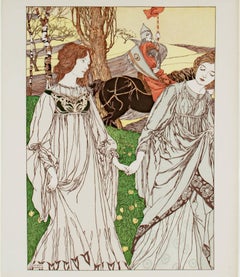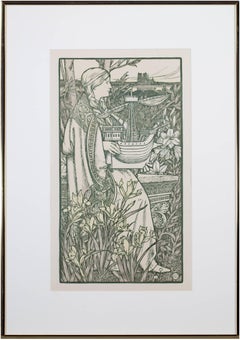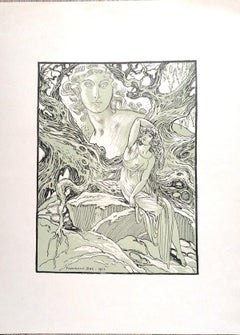Items Similar to "Invocation (L'Estampe Moderne I), " Original Color Lithograph by Marcel Lenoir
Want more images or videos?
Request additional images or videos from the seller
1 of 8
Marcel - Lenoir"Invocation (L'Estampe Moderne I), " Original Color Lithograph by Marcel Lenoir1897
1897
$6,960
£5,286.29
€6,080.20
CA$9,724.48
A$10,843.90
CHF 5,657.88
MX$133,058.74
NOK 72,015.86
SEK 68,233.46
DKK 45,378.80
Shipping
Retrieving quote...The 1stDibs Promise:
Authenticity Guarantee,
Money-Back Guarantee,
24-Hour Cancellation
About the Item
"Invocation" is an original lithograph with the blindstamp of L'Estampe Moderne in the bottom right corner. L'Estampe Moderne commissioned Marcel Lenoir to make this print for one of their Art Nouveau-inspired print publications.
15 3/4" x 12" art
23" x 19 1/4" framed
Marcel Lenoir attended the School of Decorative Arts at the Ecole des Beaux-Arts in Paris. Early in his career, he was inspired by mystic symbolism and Art Nouveau. "Invocation" showcases a boldly decorated Madonna-like figure probably gesturing to invoke the holy spirit. Lenoir's skilled use of patterns was fostered during his education, as was his appreciation for the traditional subject matter.
- Creator:
- Creation Year:1897
- Dimensions:Height: 23 in (58.42 cm)Width: 19.25 in (48.9 cm)
- Medium:
- Movement & Style:
- Period:
- Condition:
- Gallery Location:Milwaukee, WI
- Reference Number:Seller: 730d1stDibs: LU60531931873
About the Seller
4.9
Platinum Seller
Premium sellers with a 4.7+ rating and 24-hour response times
Established in 1966
1stDibs seller since 2017
435 sales on 1stDibs
Typical response time: 2 hours
- ShippingRetrieving quote...Shipping from: Milwaukee, WI
- Return Policy
Authenticity Guarantee
In the unlikely event there’s an issue with an item’s authenticity, contact us within 1 year for a full refund. DetailsMoney-Back Guarantee
If your item is not as described, is damaged in transit, or does not arrive, contact us within 7 days for a full refund. Details24-Hour Cancellation
You have a 24-hour grace period in which to reconsider your purchase, with no questions asked.Vetted Professional Sellers
Our world-class sellers must adhere to strict standards for service and quality, maintaining the integrity of our listings.Price-Match Guarantee
If you find that a seller listed the same item for a lower price elsewhere, we’ll match it.Trusted Global Delivery
Our best-in-class carrier network provides specialized shipping options worldwide, including custom delivery.More From This Seller
View All"H. L'Illusion (L'Estampe Moderne I), " Color Lithograph
By Henri Bellery-Desfontaines
Located in Milwaukee, WI
"H. L'Illusion (L'Estampe Moderne I)" is an original color lithograph by Henri Bellery-Desfontaines. This piece depicts a nude child before a dream-like woman in a blue translucent robe. This piece was published in the French Art Nouveau publication L'Estampe Moderne. Signed in plate.
15 3/4" x 12" art
Henri Bellery-Desfontaines , born with Paris in 1867 and dead the October 6th 1909, is a French Noveau artist Jack-of-All- Trades, who produced tables, illustrations, posters, lithographies, drawings of carpet, pieces of furniture and banknotes, and even dabbled with decoration & architecture.
In the 1900s, Paris was the perfect place for a group of young artists influenced by artistic currents like neogothic style or symbolism. Most of them started as painters and they switched later to decorative arts, attracted by the idea of an ever-present art, a lifeless art, a total art. Henri Bellery-Desfontaines was a member of this group and he started as as painter in Pierre-Victor Galland’s atelier. He entrusted him the decorative motifs which would frame Panthéon de Paris' drawings: Maillot, Bonnat, Humbert and specially Jean-Paul Laurens, who proposed him to join his atelier in l’École des Beaux-Arts de Paris. With him, he decorated l'Hôtel de Ville de Paris or Le Salon Lobau, Henri Bellery-Desfontaines is thought to have Luc-Olivier Merson (1846-1920) as a teacher.
During his years as a student, he started to illustrate magazines and books of tales and in 1895, Bellery-Desfontaines opted rapidly for illustration, probably due to financial problems, and he participated in magazines such as L’Image, L’Estampe Moderne or L’Almanach des Bibliophiles. This year, the Salon des Artistes Français hosted one of his design of tapestry.
From 1900 on, he gradually evolved toward an ambitious decorative artist, making tapestries and furniture for rich leaders and patrons. Bellery-Desfontaines was an important artist of his epoch, and he took part in numerous events like Bal de...
Category
1890s Art Nouveau Figurative Prints
Materials
Lithograph
"Le Passant, " Original Color Lithograph
By Robert Engels
Located in Milwaukee, WI
"Le Passant" is an original Art Nouveau color lithograph. It depicts two women in the foreground wearing medieval white robes and a knight passing behind them on a black horse. Features the L'Estampe Moderne blindstamp bottom right hand corner. 1898.
15 3/4" x 12" art
23" x 19 1/4" framed
Robert Engels studied in Dusseldorf and moved shortly thereafter to work in Munich. Later, he became a professor at a school of applied arts at the KGS in Munich. He created many decorative prints as well as stained glass windows and also created compositions to illustrate Joseph Bedier's rendition of "Tristan and Iseult...
Category
1890s Art Nouveau Figurative Prints
Materials
Lithograph
"Lutece (L'Estampe Moderne II), " Original green figurative art nouveau print
By Adolphe Giraldon
Located in Milwaukee, WI
"Lutece" is an original color lithograph by Adolphe Giraldon. This piece depicts a woman holding a sailing ship among lush vegetation. In the background, Notre Dame rises. Lutece is ...
Category
1890s Art Nouveau Figurative Prints
Materials
Lithograph
"Diane Chasseresse, " Original Color Lithograph signed by Gaston De Latenay
By Gaston de Latenay
Located in Milwaukee, WI
"Diane Chasseresse" is an original color lithograph signed by the artist Gaston de Latenay. It is edition 36/100, which is written in the lower right...
Category
1890s Art Nouveau Figurative Prints
Materials
Lithograph
Art Nouveau Lithograph 1800s Landscape Romantic Figure Floral
By Georges De Feure
Located in Milwaukee, WI
"Retour (L'Estampe Moderne I)" is a color lithograph by Georges de Feure. It features a woman with red hair in an environment of flora and fauna with muted colors and the Art Nouveau...
Category
1890s Art Nouveau Figurative Prints
Materials
Lithograph
"La Chatelaine, from 'L'Estampe Moderne, '" Lithograph by Charles Doudelet
By Charles Doudelet
Located in Milwaukee, WI
"La Chatelaine" is a color lithograph by Charles Doudelet. The artist's name is printed lower right. This piece, featuring a wealthy woman on a white horse surrounded by dogs, was published in the Art Nouveau publication L'Estampe Moderne.
15 3/4" x 12" art
19 1/4" x 23" frame
Belgian painter, sculptor, illustrator and stage designer. He studied music at the Koninklijk Muziekconservatorium and sculpture at the Gewerbeschule, Ghent (after 1877). He visited Paris in 1887 and Italy in 1890, with a grant from the city of Ghent. He was deeply impressed by the masters of the Quattrocento, and was encouraged to take up painting after meeting Constantin Meunier...
Category
1890s Art Nouveau Figurative Prints
Materials
Lithograph
You May Also Like
Art Nouveau Woman Praying - Original lithograph (1897/98)
Located in Paris, IDF
Marcel Lenoir
Art Nouveau Woman Praying (Invocation à la Madone d'onyx vert), 1897
Original lithograph (Champenois workshop)
Printed signature in the plate
On vellum, 40 x 31 cm (c....
Category
1890s Art Nouveau Portrait Prints
Materials
Lithograph
Imperia (Caprices of Verlaine) - Original Lithograph 1899
Located in Paris, IDF
Alfred Pierre AGACHE (1843-1915)
Imperia (Caprices of Verlaine), 1899
Original lithograph (Champenois workshop)
Printed signature in the plate
On vellum, 40 x 31 cm (c. 16 x 12 in)
...
Category
1890s Art Nouveau Figurative Prints
Materials
Lithograph
Renewal - Original lithograph - 1897
By Émile Berchmans
Located in Paris, IDF
Emile BERCHMANS
Renewal
Original lithograph
Printed signature in the plate
1897/98
Printed on paper Vélin
Size 40 x 31 cm (c. 16 x 12")
INFORMATION : Published by 'Estampe Modern...
Category
1890s Art Nouveau Figurative Prints
Materials
Lithograph
The Goddess - Lithograph by Ferdinand Bac - 1923
Located in Roma, IT
The Goddess is an original modern artwork realized by Ferdinand Bac (1859 - 1952) in 1923.
Signed and dated on plate on the lower left corner: Ferdinand...
Category
1920s Art Nouveau Figurative Prints
Materials
Lithograph
Gonthier-Meymans by Henri Meunier, Art Nouveau Japon lithograph, 1897
By Henri Meunier
Located in Chicago, IL
Henri Meunier’s Gonthier-Meymans lithographic poster, published by Verlag von Gerhard Kühtmann in Dresden, 1897. While this poster was printed in multiple sizes and formats, this edi...
Category
1890s Art Nouveau Prints and Multiples
Materials
Lithograph
The Awakening - Original Lithograph by F. Bac - 1922
Located in Roma, IT
The Awakening is an original modern artwork realized by Ferdinand Bac (1859 - 1952) in 1922.
Original Lithograph on ivory paper. Signed and dated on plate on the lower right corner: F. Bac 1922.
Excellent conditions.
The Awakening depicts a very interesting scene. A girl below is awakened by an apparition of a standing and monumental female figure on her right. She is, according to the headdress, the Goddess Minerva, goddess of the wisdom. the Goddess is taking off a veil to reveal herself. On the right you can see a glimpse of vegetation; the figures indeed are surrounded by dense vegetation.
Ferdinand Bac (1859 - 1952). Ferdinand-Sigismond Bach, known as Ferdinand Bac was a French cartoonist, artist and writer, son of an illegitimate nephew of the Emperor Napoleon. As a young man, he mixed in the fashionable world of Paris of the Belle Époque, and was known for his caricatures, which appeared in popular journals. He also traveled widely in Europe and the Mediterranean. In his fifties, he began a career as a landscape gardener. He attended Adolphe Thiers, Gambetta, Richard Wagner, Victor Hugo, Taine, Villiers de L'Isle-Adam, Paul Verlaine, Maurice Barrès, Barbey d'Aurevilly, Alphonse Daudet, Guy de Maupassant, Verdi, Gounod, Pierre de Nolhac, and many more other famous people of the time. He established himself as one of the first cartoonists and caricaturists of his time, as famous as Albert Robida...
Category
1920s Art Nouveau Figurative Prints
Materials
Lithograph
